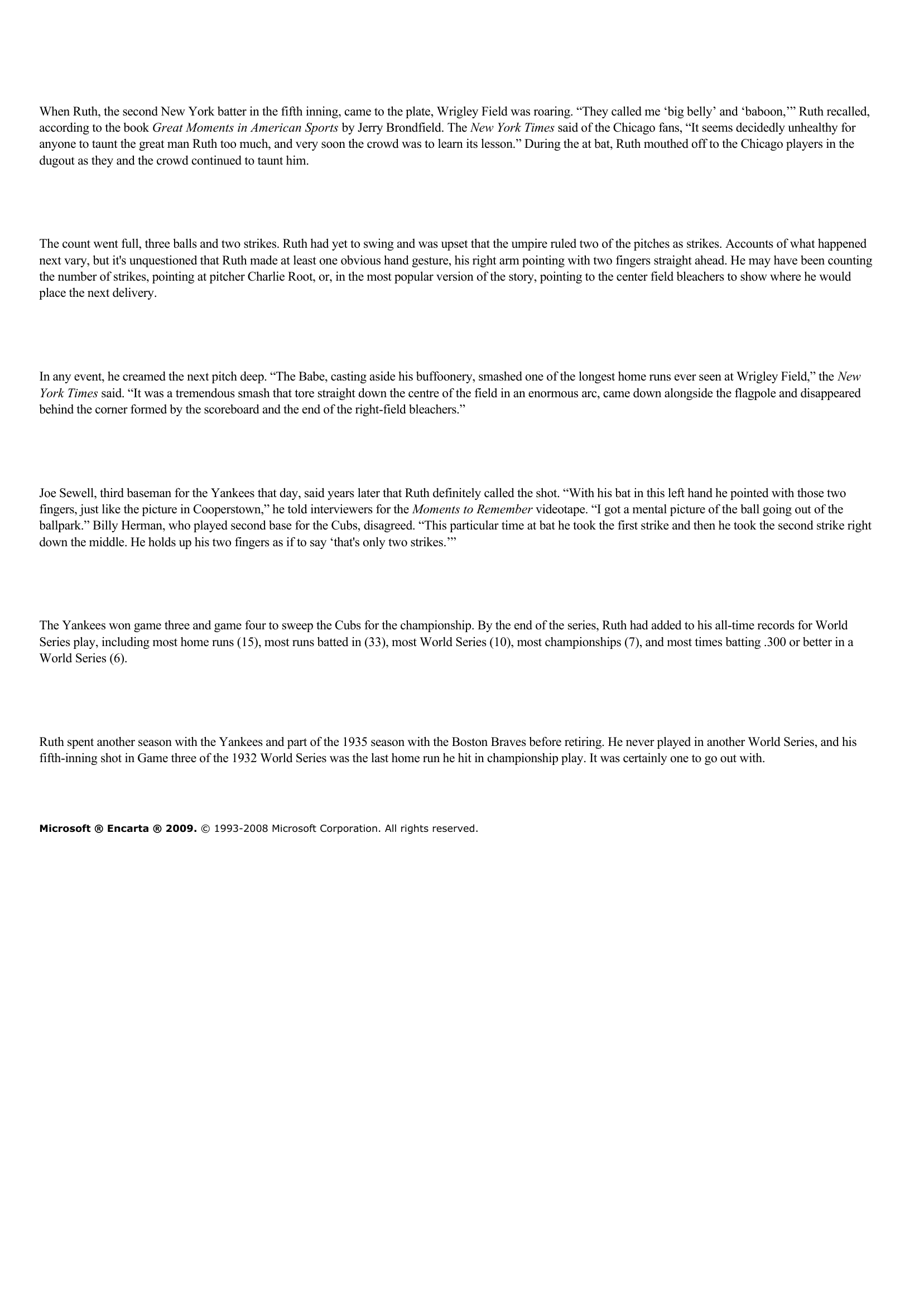Babe Ruth's "Called Shot".
Publié le 14/05/2013

Extrait du document
«
When Ruth, the second New York batter in the fifth inning, came to the plate, Wrigley Field was roaring.
“They called me ‘big belly’ and ‘baboon,’” Ruth recalled,according to the book Great Moments in American Sports by Jerry Brondfield.
The New York Times said of the Chicago fans, “It seems decidedly unhealthy for anyone to taunt the great man Ruth too much, and very soon the crowd was to learn its lesson.” During the at bat, Ruth mouthed off to the Chicago players in thedugout as they and the crowd continued to taunt him.
The count went full, three balls and two strikes.
Ruth had yet to swing and was upset that the umpire ruled two of the pitches as strikes.
Accounts of what happenednext vary, but it's unquestioned that Ruth made at least one obvious hand gesture, his right arm pointing with two fingers straight ahead.
He may have been countingthe number of strikes, pointing at pitcher Charlie Root, or, in the most popular version of the story, pointing to the center field bleachers to show where he wouldplace the next delivery.
In any event, he creamed the next pitch deep.
“The Babe, casting aside his buffoonery, smashed one of the longest home runs ever seen at Wrigley Field,” the New York Times said.
“It was a tremendous smash that tore straight down the centre of the field in an enormous arc, came down alongside the flagpole and disappeared behind the corner formed by the scoreboard and the end of the right-field bleachers.”
Joe Sewell, third baseman for the Yankees that day, said years later that Ruth definitely called the shot.
“With his bat in this left hand he pointed with those twofingers, just like the picture in Cooperstown,” he told interviewers for the Moments to Remember videotape.
“I got a mental picture of the ball going out of the ballpark.” Billy Herman, who played second base for the Cubs, disagreed.
“This particular time at bat he took the first strike and then he took the second strike rightdown the middle.
He holds up his two fingers as if to say ‘that's only two strikes.’”
The Yankees won game three and game four to sweep the Cubs for the championship.
By the end of the series, Ruth had added to his all-time records for WorldSeries play, including most home runs (15), most runs batted in (33), most World Series (10), most championships (7), and most times batting .300 or better in aWorld Series (6).
Ruth spent another season with the Yankees and part of the 1935 season with the Boston Braves before retiring.
He never played in another World Series, and hisfifth-inning shot in Game three of the 1932 World Series was the last home run he hit in championship play.
It was certainly one to go out with.
Microsoft ® Encarta ® 2009. © 1993-2008 Microsoft Corporation.
All rights reserved..
»
↓↓↓ APERÇU DU DOCUMENT ↓↓↓
Liens utiles
- Babe Ruth's 60th Home Run.
- Babe Ruth.
- Hank Aaron Hank Aaron, born in 1934, American baseball player, nicknamed Hammerin' Hank, whose 755 home runs broke the all-time record previously held by Babe Ruth.
- Analyse Before the Shot 3e
- RUTH - « Ancien Testament » (Bible)





